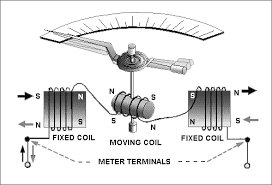Electrodynamometer type instruments:
The necessity for the AC calibration of moving iron instruments as well as another type of instruments which cannot be correctly calibrated requires the use of a transfer type of instrument. A transfer instrument is one that may be calibrated with a d.c source and then used without modification to measure a.c. This requires the transfer type instrument to have the same accuracy for both a.c and d.c, which have electrodynamometer instruments have.
Electrodynamometer instruments are capable of serving as transfer instruments. Indeed, their principal use as ammeters and voltmeters in laboratory and measurement work and as standards for calibration of other instruments as their accuracy is very high.
Electrodynamometer type instruments are used as a.c voltmeters and ammeters both in the range of power frequencies and lower part of the audio frequency range. They are used as watt-meters,varmeters and with some modification as power factor meters and frequency meters.
Operation Principle of Electrodynamometer type instrument:
We have an idea of the working principle of electrodynamometer instrument by taking up a permanent magnet moving coil instrument and considering how it would behave on a.c. It would have a torque in one direction during one half of the cycle and an equal effect in the opposite direction during the other half of the cycle. If the frequency were very low, the pointer would swing back and forth around the zero points.
However, for an ordinary meter, the inertia is so great that on power frequencies the pointer does not go very far in either direction but merely stays(vibrates slightly) around zero. If, however, we were to reverse the direction of the flux each time the current through the movable coil reverses, a unidirectional torque would be produced for both positive and negative halves of the cycle.
In electrodynamometer instruments, the field can be made of reverse simultaneously with the current in the movable coil if the field(fixed) coil is connected in series with the movable coil.
This textbook “Electrical and Electronics Measurements by S. Chand” is the best in industry. Grab it now for very less price.
Construction of Electrodynamometer type instrument:
Fixed coils:
The field is produced by a fixed coil. This coil is divided into 2 sections to give a more uniform field near the centre and to allow passage of the instrument shaft. The instrument as shown below may be a milliammeter, or may become a fixed coil are wound which fine wire for such applications.

Fixed coils are usually wound with the heavy wire carrying the main current in ammeters and wattmeters. The wire is stranded where necessary to reduce eddy current losses in conductors. The coils are usually varnished and baked to form a solid assembly. These are then clamped in place against the coil supports. This makes the construction rigid so that there is no shifting or change in dimensions which might affect the calibration.
The mounting supports are preferably made out of ceramics, as metal parts would weaken the field of the fixed coil on account of eddy currents.
Moving coil:
A single element instrument has one moving coil. The moving coil is wound either as a self-sustaining coil or else on a non-metallic former. A metallic former cannot be used as eddy currents would be induced in it by the alternating field. Light but rigid construction is used for the moving coil. It should be noted that both fixed and moving coil are air core.
Controlling torque:
The controlling torque is provided by two control springs. These springs act as leads to then moving coil.
Moving system:
The moving coil is mounted on an aluminium spindle. The movie system also carries the counterweights and truss type pointer. Sometimes a suspension may be used in case a high sensitivity is desired.
Damping torque:
Air friction damping is employed for these instruments and is provided by a pair of aluminium vanes, attached to the spindle at the bottom. These vanes move in sector shaped chambers. Eddy current damping cannot be used in these instruments as the operating field is very weak and any introduction of a permanent magnet required fun eddy current damping would desert the operating magnetic field of the instrument.
Shielding:
The field produced by the fixed coils he is somewhat weaker than in other types of instruments. It is nearly 0.005 to 0.006 Wb/m*m . In dc measurements, even the Earth’s magnetic field may affect the readings. Thus it is necessary to shield and electrodynamometer type instrument from the effect of stray magnetic fields.
Air cored electrodynamometer instruments are protected against external magnetic fields by enclosing them in a casing of high permeability alloy. This shunts external magnetic fields around the instrument mechanism and minimises their effects on the indication.
Cases and scales:
Laboratory standard instruments are usually contained in high polished wooden cases. These cases also constructed to remain dimensionally stable over long periods of time. The glass is coated with some conducting material to completely remove the electrostatic effects. The case is supported by adjustable levelling screws. A spirit level is also provided to ensure proper levelling.
The sales are hand drawn, using machine subdividing equipment. Diagonal lines for fine subdivision are usually drawn for main markings on the scale. Most of the high precision instruments have a 300mm scale with 100,200 or 150 divisions.